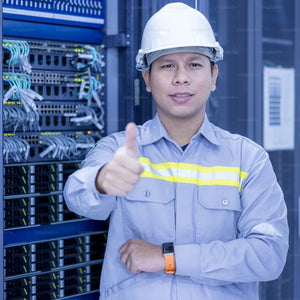Cisco Industrial Ethernet (IE) switches, specifically the IE 2000, IE 3000, and IE 4000 series, provide reliable and secure network connectivity designed explicitly for industrial environments.
These switches excel in rugged conditions, offering superior durability, resilience, and performance suitable for sectors like manufacturing, transportation, energy, and smart cities.
This guide provides an overview of features, technical specifications, model comparisons, stacking capabilities, naming conventions, and FAQs for Cisco IE series switches.
Product Features
- Ruggedized Design: Designed to withstand extreme temperatures, vibrations, shock, humidity, and dust, Cisco IE switches ensure stable performance in harsh industrial environments.
- Advanced Security: Featuring port security, Access Control Lists (ACLs), MAC address filtering, and 802.1X authentication, these switches protect networks from unauthorized access and cyber threats.
- Redundant Power Supply: Supports dual DC power inputs, ensuring uninterrupted operation in case one power source fails.
- Power over Ethernet (PoE/PoE+): Capable of powering IP cameras, sensors, and wireless access points, simplifying network infrastructure and reducing wiring complexity.
- Layer 2 and Layer 3 Capabilities: IE switches offer VLAN support, QoS, and robust routing capabilities for effective traffic management and enhanced network reliability.
Cisco IE Series Models
Cisco IE 2000 Series
| Model | Ports | PoE Ports | Uplink Ports | Layer Support | Environment |
| IE-2000-4TS-G-B | 4 x FE | 0 | 2 x Gigabit | Layer 2 | Industrial/Outdoor |
| IE-2000-8TC-G-E | 8 x FE | 0 | 2 x Gigabit | Layer 2 | Industrial |
| IE-2000-8PTC-G-E | 8 x FE | 8 PoE+ | 2 x Gigabit | Layer 2 | Industrial (PoE capable) |
Cisco IE 3000 Series
| Model | Ports | PoE Ports | Uplink Ports | Layer Support | Environment |
| IE-3000-4TC | 4 x FE | 0 | 2 x Gigabit | Layer 2 & 3 | Industrial |
| IE-3000-8TC | 8 x FE | 0 | 2 x Gigabit | Layer 2 & 3 | Industrial |
| IE-3000-8TC-E | 8 x FE | 0 | 2 x Gigabit | Layer 2 & 3 | Extended Environment |
| IE-3000-8PTC-E | 8 x FE | 8 PoE+ | 2 x Gigabit | Layer 2 & 3 | Extended Environment |
Cisco IE 4000 Series
| Model | Ports | PoE Ports | Uplink Ports | Layer Support | Environment |
| IE-4000-8GT4G-E | 8 x Gigabit | 0 | 4 x Gigabit | Layer 2 & 3 | Extended Environment |
| IE-4000-8GS4G-E | 8 x Gigabit SFP | 0 | 4 x Gigabit | Layer 2 & 3 | Extended Environment |
| IE-4000-8GP4G-E | 8 x Gigabit PoE+ | 8 PoE+ | 4 x Gigabit | Layer 2 & 3 | Extended Environment |
| IE-4000-16GT4G-E | 16 x Gigabit | 0 | 4 x Gigabit | Layer 2 & 3 | Extended Environment |
How to Stack Cisco IE Switches:
Cisco IE switches support stacking through Cisco's proprietary FlexStack technology, allowing up to four switches to be combined into a single logical unit. This stacking:
- Enhances redundancy and resiliency
- Simplifies network management
- Provides increased bandwidth and easier network expansion
Stacking is managed through the Cisco IOS software, making it straightforward to configure and operate.
Product Naming Convention
Understanding the naming convention:
- IE: Industrial Ethernet
- 2000, 3000, 4000: Series indicating feature sets and capabilities (higher numbers typically indicate higher capabilities and performance).
- Port Configurations: T (Copper), S (Fiber SFP), P (PoE)
- Environment Indicators: E (Extended environmental support), B (Basic environmental support)
FAQ for Cisco IE Series Switches
Q1: What's the difference between Cisco IE 2000 and IE 4000 switches?
A1: IE 2000 switches are entry-level Layer 2 switches suitable for basic industrial applications. IE 4000 series offers advanced Layer 2 and Layer 3 capabilities, higher port density, and enhanced environmental protection suitable for mission-critical applications.
Q2: Do Cisco IE switches support PoE?
A2: Yes, specific models in each series, such as IE-2000-8PTC-G-E and IE-4000-8GP4G-E, support PoE and PoE+.
Q3: Can IE switches operate in extreme temperatures?
A3: Yes, IE switches are designed for industrial environments and can typically operate from -40°C to +75°C, depending on the model.
Q4: What security features do Cisco IE switches provide?
A4: Cisco IE switches include 802.1X authentication, MAC address filtering, port security, and Access Control Lists (ACLs) for comprehensive network security.
Q5: Are Cisco IE switches stackable?
A5: Yes, Cisco IE 3000 and IE 4000 series support Cisco FlexStack technology, enabling stacking capabilities.
Conclusion:
Cisco IE 2000, IE 3000, and IE 4000 series industrial switches are robust solutions for demanding industrial environments. With rugged designs, advanced security features, stacking capabilities, and PoE support, they ensure reliable, secure, and scalable industrial networking suitable for diverse operational scenarios.
Did this article help you or not? Tell us on Facebook and LinkedIn . We’d love to hear from you!






 https://network-switch.com
https://network-switch.com





















